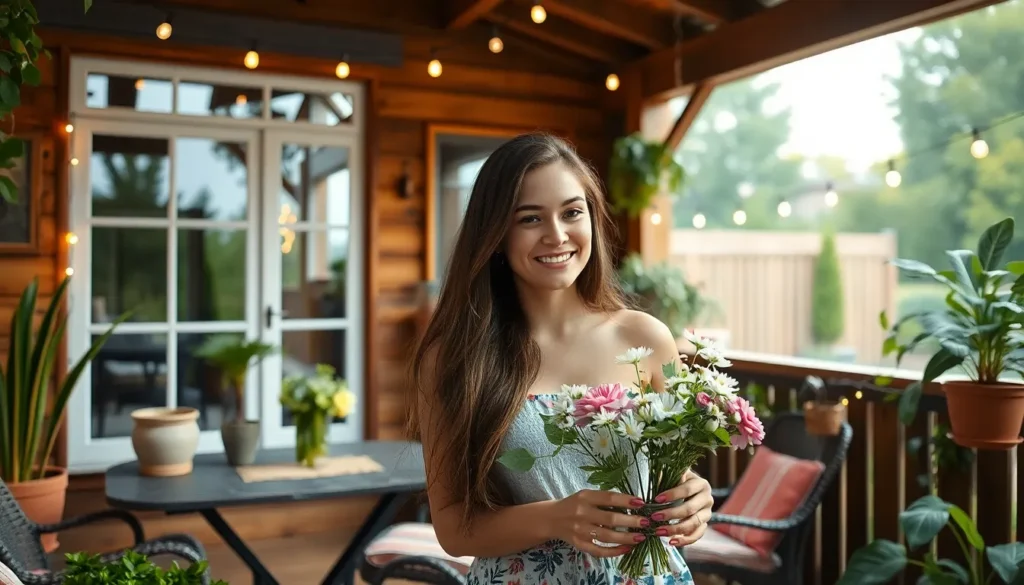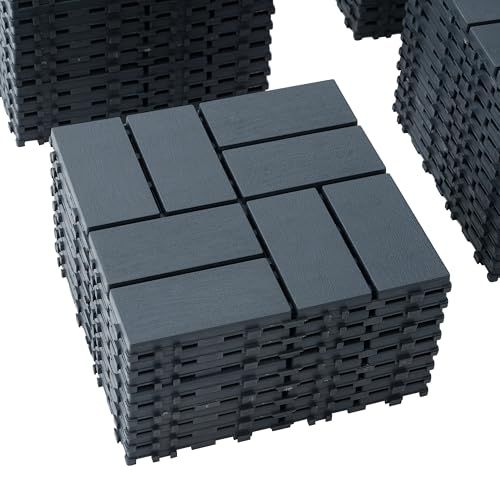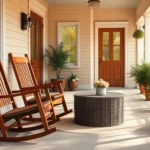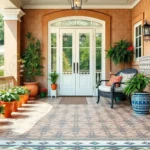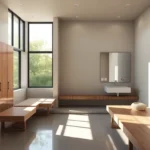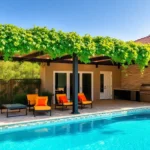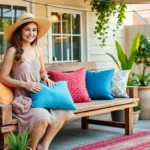We all dream of having that perfect outdoor retreat where we can relax year-round without very costly. An enclosed patio offers the ideal solution – giving you protection from weather elements while maintaining that coveted indoor-outdoor living experience. The best part? You don’t need to spend thousands to create your own backyard sanctuary.
Budget-friendly enclosed patio projects can transform any ordinary outdoor space into a functional extension of your home. Whether you’re dealing with harsh winters unpredictable rain or blazing summer heat we’ll show you how to create a comfortable enclosed area that serves your family’s needs without emptying your wallet.
From simple DIY screen installations to creative repurposing ideas we’ve gathered the most cost-effective strategies that deliver maximum impact. You’ll discover how everyday materials and smart planning can help you build the enclosed patio you’ve always wanted – all while staying within your budget constraints.
DIY Screen Enclosure Solutions for Maximum Savings
Screen enclosures offer the perfect balance between outdoor freedom and weather protection. We can create professional-looking results at a fraction of the commercial installation cost.
Building Your Own Screen Walls
Building screen walls requires basic tools and materials available at most home improvement stores. We recommend starting with pressure-treated lumber for the frame structure, as it withstands moisture and insects better than standard wood. Pine 2x4s cost approximately $3-5 per board, making them an affordable foundation for your screen wall project.
Creating the frame begins with measuring your patio dimensions accurately. We suggest planning wall sections no larger than 8 feet wide for structural stability and easier handling. Standard fiberglass screening runs about $0.30-0.50 per square foot, allowing us to cover substantial areas without breaking our budget.
Assembly involves cutting lumber to size and joining corners with galvanized screws or brackets. We find that pre-drilling holes prevents wood splitting and ensures stronger connections. Wood screws typically cost $8-12 per box, providing enough fasteners for multiple wall sections.
Attaching the screening requires stretching the material taut across the frame. We use screen spline and a roller tool to secure edges in routed grooves. Screen spline costs around $0.25 per linear foot, making it an economical way to achieve professional-looking installations.
Repurposing Materials for Screen Frames
Repurposing existing materials dramatically reduces our screen enclosure costs while creating unique design elements. Old wooden pallets serve as excellent frame foundations, requiring only basic modification to accommodate screening material.
Dismantling pallets safely involves removing nails and sanding rough surfaces smooth. We can create attractive rustic frames by maintaining the weathered wood appearance while ensuring structural integrity. Pallet wood saves us 60-80% compared to new lumber purchases.
Salvaged windows make exceptional screen wall components when we replace glass with screening material. Vintage windows from architectural salvage yards typically cost $15-40 each, providing character and functionality in one affordable package.
PVC pipe offers another cost-effective framing solution for lightweight screen panels. We can build removable sections using standard plumbing fittings and connectors. A 10-foot section of 2-inch PVC pipe costs approximately $8-12, allowing us to create multiple panel frames economically.
Installing Roll-Up Screens for Flexibility
Roll-up screens provide versatility by allowing us to open or close sections based on weather conditions and personal preference. Manual roll-up screen systems cost $25-45 per linear foot when purchased as DIY kits, significantly less than professional installations.
Mounting hardware requires secure attachment points along the top of our patio structure. We install heavy-duty brackets capable of supporting the screen weight and wind resistance. Galvanized mounting brackets typically cost $5-8 per set, ensuring long-lasting performance in outdoor conditions.
Operating mechanisms include spring-loaded systems and crank handles for larger installations. We prefer spring-loaded options for smaller sections up to 6 feet wide due to their simplicity and reliability. Spring-loaded mechanisms add approximately $15-20 to each screen section but provide years of trouble-free operation.
Weather sealing around roll-up screen edges prevents insects and debris from entering our enclosed space. We use brush strips or rubber seals along the sides and bottom tracks. Weather sealing materials cost $2-4 per linear foot, creating an effective barrier while maintaining smooth screen operation.
Budget-Friendly Glass Panel Alternatives
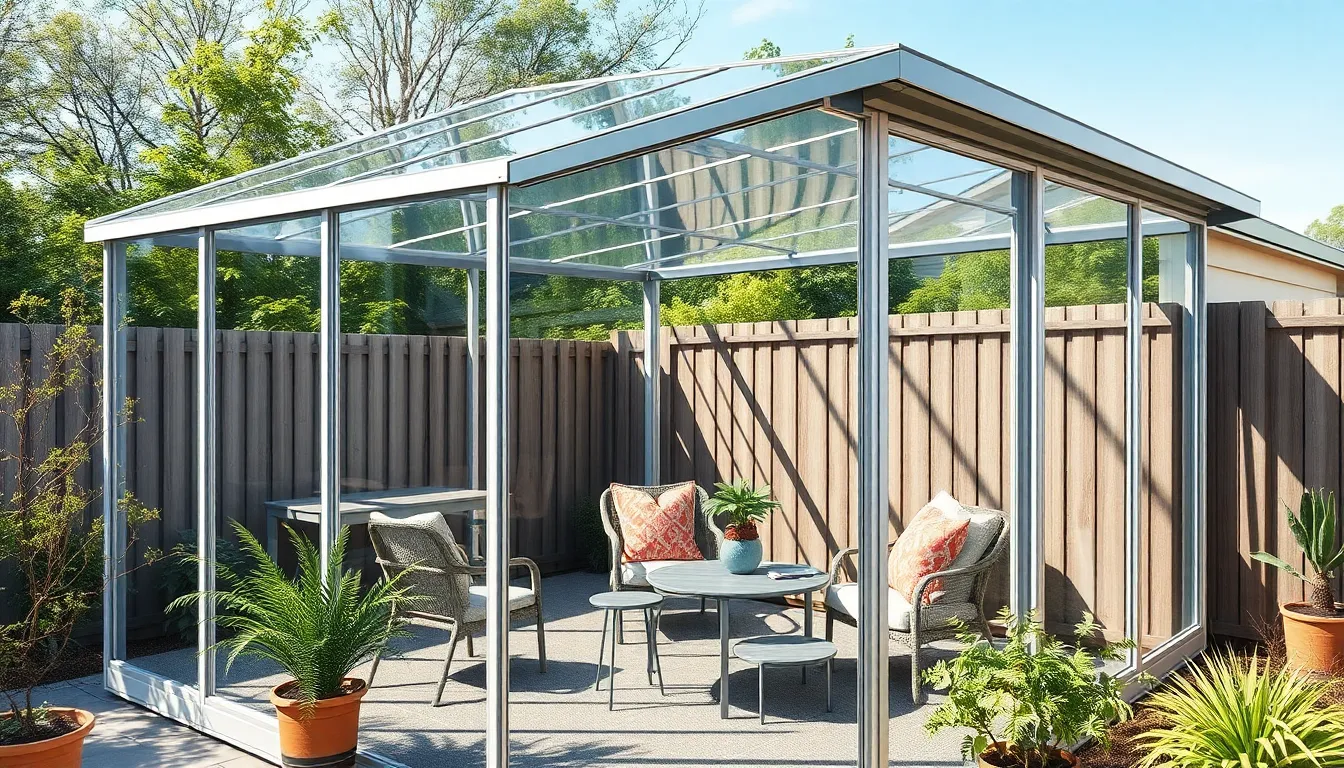
Traditional glass panels can strain your patio enclosure budget significantly. We’ve discovered several cost-effective alternatives that deliver excellent weather protection while maintaining clear visibility.
Acrylic Sheeting for Weather Protection
Acrylic sheets provide outstanding value as lightweight, impact-resistant alternatives to expensive glass panels. These durable materials offer clear visibility similar to traditional glass while costing substantially less per square foot. Weather resistance makes acrylic sheeting ideal for year-round patio enclosures, effectively blocking wind and rain without compromising natural light.
Custom sizing capabilities allow acrylic sheets to fit various patio dimensions perfectly. Installation proves much simpler compared to heavy glass panels, reducing both labor costs and structural requirements. Permanent or seasonal applications work equally well with acrylic materials, giving you flexibility in your enclosure design.
Plexiglass Installation Techniques
Mounting plexiglass panels requires only basic fasteners, tracks, or simple wooden frames for secure installation. Simple bracket systems allow panels to attach directly to existing patio structures without extensive modifications. Weather stripping around all edges creates tight seals that prevent rain and wind infiltration effectively.
Hinged panel designs enable easy ventilation control during pleasant weather conditions. Sliding track systems offer another flexible option for opening and closing sections as needed. Proper installation techniques prevent warping and extend your plexiglass enclosure’s lifespan significantly, maximizing your investment value.
Clear Vinyl Curtains as Temporary Answers
Clear vinyl curtains deliver the most budget-friendly enclosure option for seasonal patio protection. These flexible materials roll up easily when you want open-air enjoyment and deploy quickly during inclement weather. Track systems or simple curtain rods provide straightforward hanging mechanisms without requiring structural modifications.
Removal and storage become effortless tasks during off-seasons, making vinyl curtains perfect for renters or temporary installations. Quick installation means you can have weather protection in place within hours rather than days. Cost effectiveness makes this solution accessible for almost any budget while still providing meaningful protection from wind, rain, and debris.
Creative Fabric and Textile Enclosures
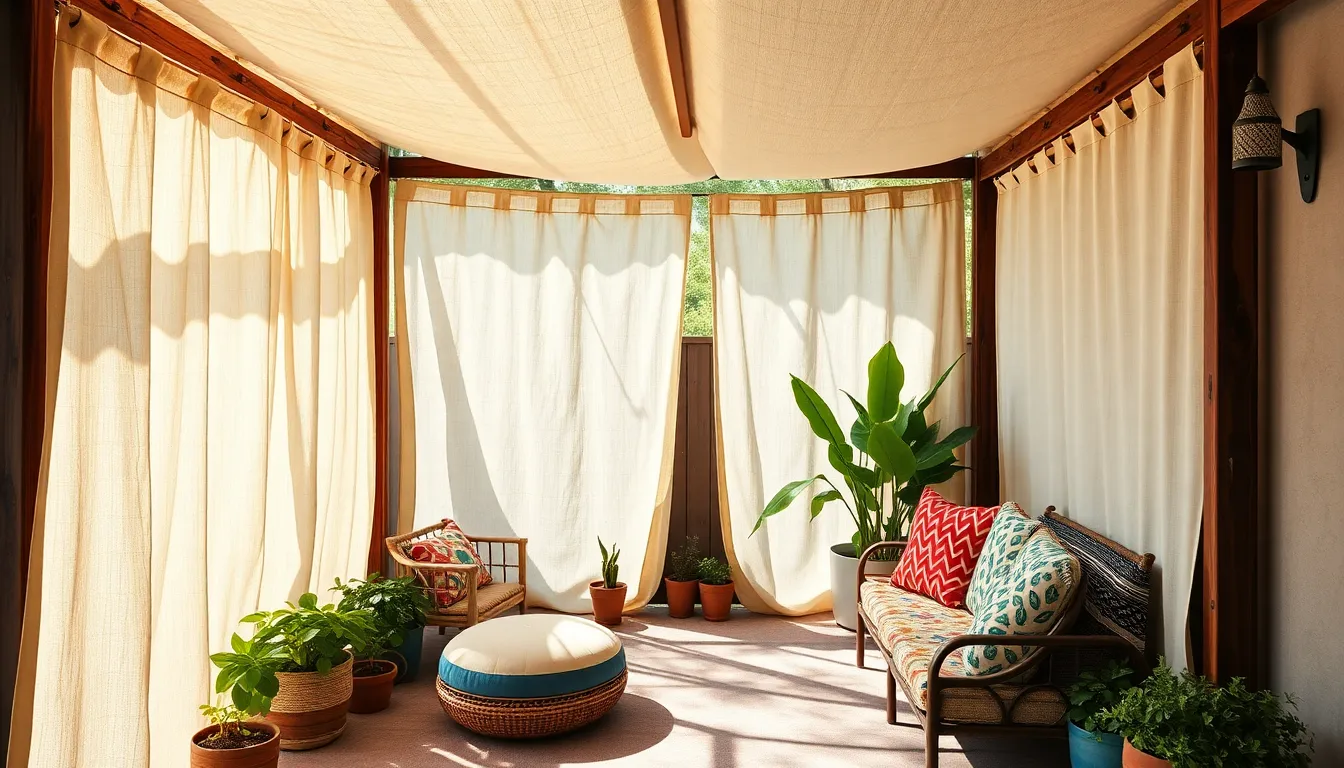
Fabric and textile options offer versatile alternatives to rigid glass or screen answers. These materials provide excellent airflow control while maintaining privacy and weather protection at a fraction of traditional construction costs.
Drop Cloth Curtain Systems
Drop cloth curtains transform any patio into a cozy enclosed space using affordable cotton or canvas materials. We recommend installing these practical barriers on curtain rods or wire cables for easy operation throughout different seasons. Their paintable and stainable surfaces allow complete customization to match your existing decor style.
Installation costs typically range from $3-8 per linear foot, making drop cloths one of the most economical patio enclosure options available. Canvas drop cloths provide superior durability compared to lightweight fabrics while offering protection against light rain and wind. We suggest choosing heavier weight materials for areas with frequent weather exposure.
Maintenance requirements remain minimal since most drop cloth materials are machine washable or can be spot cleaned with mild detergent. Their removable nature allows for seasonal storage when full enclosure isn’t needed.
Canvas Tarp Weather Barriers
Canvas tarps deliver robust weather resistance while maintaining budget friendly pricing for patio enclosures. These durable barriers attach directly to existing patio frames using ties, clips, or screws for secure installation. We’ve found canvas materials handle harsh weather conditions better than standard fabric curtains.
Weather protection capabilities include:
- Rain deflection during moderate storms
- Wind barrier reducing drafts by up to 80%
- UV protection blocking harmful sun exposure
- Dust and debris filtration
Cost effectiveness makes canvas tarps attractive with prices starting around $15-25 for standard patio coverage. Their seasonal removal capability allows for year round flexibility without permanent structural changes. We recommend choosing grommeted tarps for easier installation and improved wind resistance.
Heavy duty canvas materials last 3-5 years with proper care, providing excellent return on investment compared to fixed wall installations.
Outdoor Fabric Panel Installation
Outdoor fabric panels create sophisticated enclosed spaces using large fabric sheets mounted within frames or between posts. These installations offer superior customization options while maintaining budget conscious pricing. We suggest pairing fabric panels with bamboo screens or wooden lattice for enhanced privacy and natural aesthetics.
Installation methods vary based on your setup:
- Fixed panels between permanent posts
- Movable panels with track systems
- Tension wire installations for flexibility
- Frame mounted options for stability
Fabric panel benefits include excellent light diffusion while preserving airflow throughout the enclosed space. Their quick installation process requires minimal tools and can typically be completed in one afternoon. We recommend choosing outdoor rated fabrics with UV protection for extended lifespan.
Customization possibilities are extensive with fabric panels available in many colors, patterns, and textures to complement any patio design. Combining different panel heights creates visual interest while maintaining functional privacy barriers.
Repurposed Materials for Patio Walls
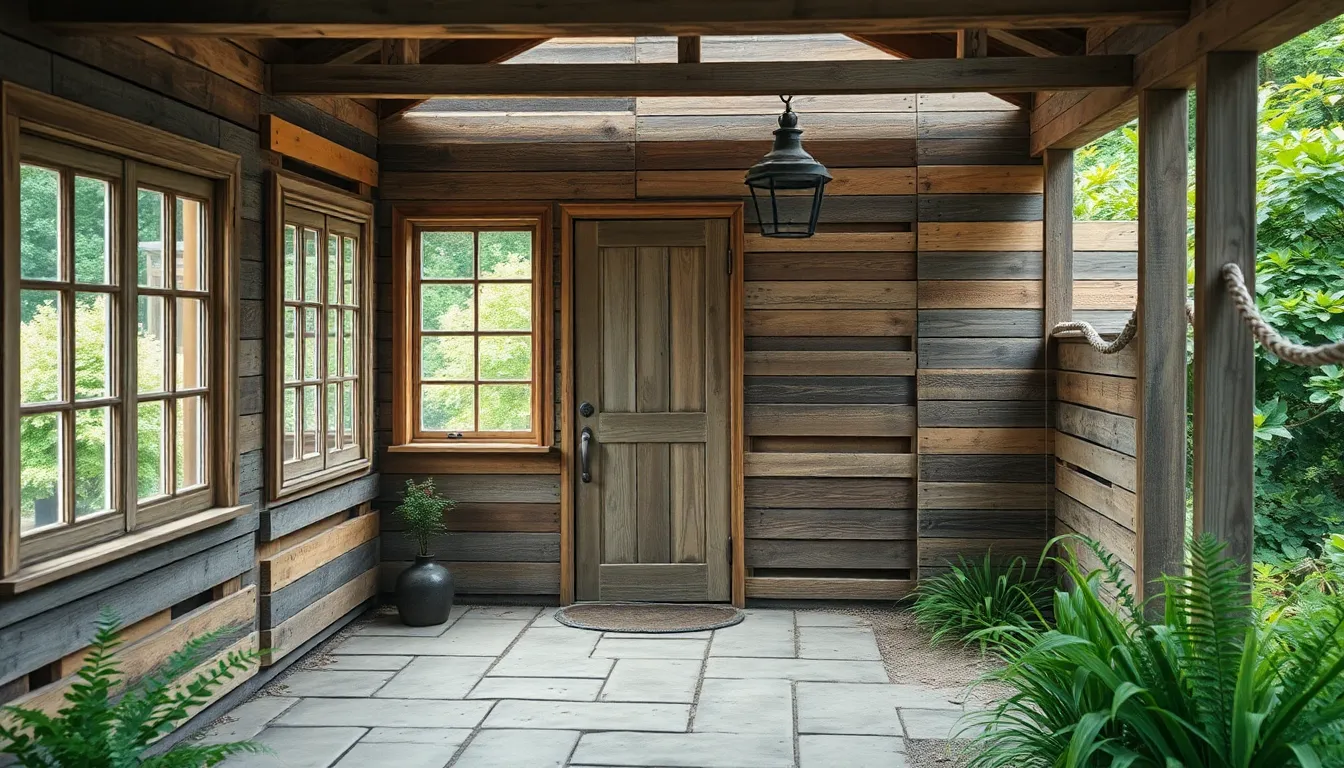
We can create stunning patio walls by transforming forgotten materials into functional design elements. These reclaimed treasures offer both important cost savings and unique character that new materials simply can’t match.
Reclaimed Window Transformations
Vintage windows become beautiful wall inserts that flood your enclosed patio with natural light while maintaining protection from the elements. We’ve found that old window frames create a charming “greenhouse effect” that blocks insects while preserving airflow throughout the space.
Combining reclaimed windows with screens or plexiglass delivers an inexpensive yet functional wall solution. The glass panes can be replaced with weather-resistant materials to suit your climate needs. Multiple windows arranged in patterns create visual interest and serve as conversation starters for guests.
Framing techniques for window installation require basic carpentry skills and standard lumber. We recommend measuring each window frame carefully since vintage sizes often vary from modern standards. Weatherstripping around the frames ensures proper sealing against wind and moisture.
Pallet Wall Construction Methods
Disassembling pallets properly starts with removing nails and hardware using a pry bar or reciprocating saw. We always sand the reclaimed wood to eliminate splinters and create smooth surfaces ready for finishing. This preparation step prevents injuries and ensures professional looking results.
Arranging pallet planks horizontally or vertically creates different aesthetic effects for your patio walls. Horizontal installation produces a modern, streamlined appearance while vertical placement emphasizes height and creates visual drama. We often mix both orientations within the same project for added interest.
Staining or painting pallet wood weatherproofs the material and allows complete customization of your patio’s color scheme. Clear stains preserve the natural wood grain while colored stains and paints offer unlimited design possibilities. We recommend using exterior grade finishes to ensure longevity against weather exposure.
Salvaged Door Integration Ideas
Old doors function as swinging or sliding patio entrances that provide easy access to your enclosed space. We’ve successfully converted barn doors, screen doors, and even interior doors into charming patio entryways. The key lies in proper hardware selection and weatherproofing treatments.
Incorporating doors into wall panels creates decorative focal points that break up large wall surfaces. Single doors can serve as privacy screens or room dividers within larger patio spaces. We often position doors at angles to create interesting geometric patterns.
Multiple doors hinged together form flexible folding screens that adapt to changing weather conditions and privacy needs. This accordion style arrangement allows sections to be opened or closed as needed. We recommend using exterior hinges and adding weather stripping between door sections for optimal performance.
Painting or refinishing salvaged doors personalizes your patio while extending the material’s lifespan. We strip old paint and apply primer before adding topcoats in colors that complement your home’s exterior. This refinishing process transforms weathered doors into attractive architectural elements.
Seasonal Enclosure Options That Save Money
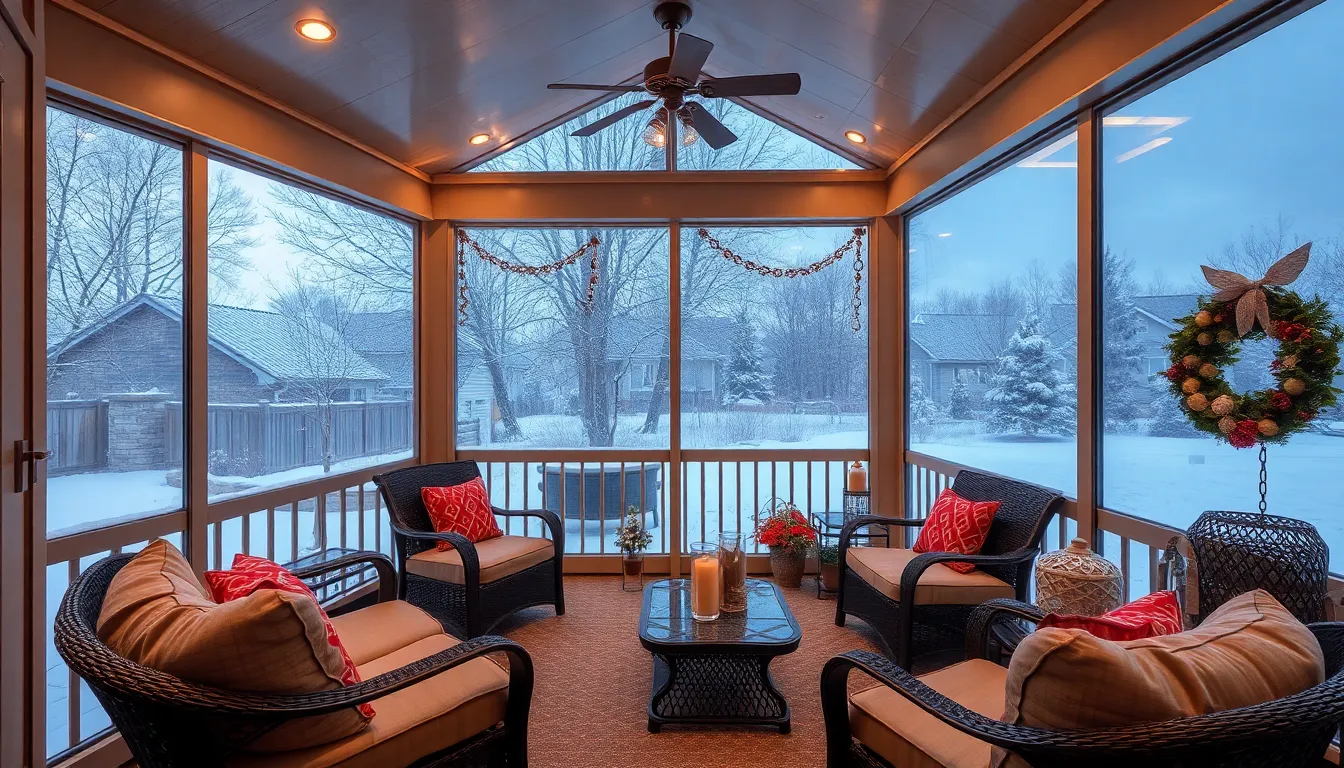
We’ve explored permanent answers, but seasonal approaches offer the perfect balance between functionality and affordability. These flexible systems let us adapt our enclosed patio to changing weather conditions without the commitment of year-round installations.
Removable Winter Coverings
Heavy-duty clear vinyl curtains transform our patio into a protected winter retreat without permanent modifications. We can install these transparent barriers using simple grommets and outdoor curtain rods, creating an enclosed space that blocks wind and precipitation while maintaining visibility. The installation takes just a few hours, and removal becomes effortless when spring arrives.
Insulated panels provide superior cold weather protection for patios that need extra warmth retention. We position these lightweight panels between existing posts or attach them to temporary frames using basic hardware. Each panel typically costs 40-60% less than permanent glass installations while offering comparable insulation properties.
Snap-on panel systems work exceptionally well for pergolas and gazebos that already have structural support. We secure these panels using industrial-strength snaps or Velcro strips, allowing quick seasonal changes without tools. The panels store compactly during warmer months, preventing wear and extending their lifespan significantly.
Summer Screen Answers
Retractable mesh screens offer the ultimate flexibility for warm weather patio use. We install these systems on tracks or roller mechanisms that allow screens to slide or roll away when not needed. Standard mesh screening costs approximately $2-4 per square foot, making this solution highly budget-friendly compared to permanent screen rooms.
DIY screen panels provide custom-sized protection that we can build using pressure-treated lumber frames and fiberglass screening. Each panel typically measures 3×6 feet and costs around $25-35 to construct. We connect multiple panels using hinges or brackets to create larger enclosed areas that adapt to our exact patio dimensions.
Tension screen systems use cables or wire frameworks to support lightweight screening without heavy structural requirements. We stretch screens between posts using turnbuckles and clamps, creating protected areas that disassemble easily for storage. This approach works particularly well for irregular patio shapes that standard panels can’t accommodate.
Year-Round Convertible Systems
Sliding panel combinations merge screens and solid panels in track systems that we can rearrange based on seasonal needs. We slide screen panels forward during summer months for airflow and move solid panels into position for winter weather protection. These systems typically cost 30-50% less than fully enclosed sunrooms while providing similar versatility.
Bamboo reed screen layering creates privacy and wind protection that we can adjust throughout the year. We hang different density screens on the same mounting system, using lighter screens for summer shade and denser options for winter wind blocking. Each bamboo screen panel costs $15-25 and lasts 3-5 years with proper care.
Outdoor curtain rotation systems allow us to change fabric weights and materials seasonally without replacing hardware. We use the same curtain rods and tracks year-round, switching from lightweight summer fabrics to heavy-duty winter materials. This approach reduces installation costs while maintaining the flexibility to adapt our patio’s appearance and function to match seasonal requirements.
Multi-Purpose Enclosure Designs
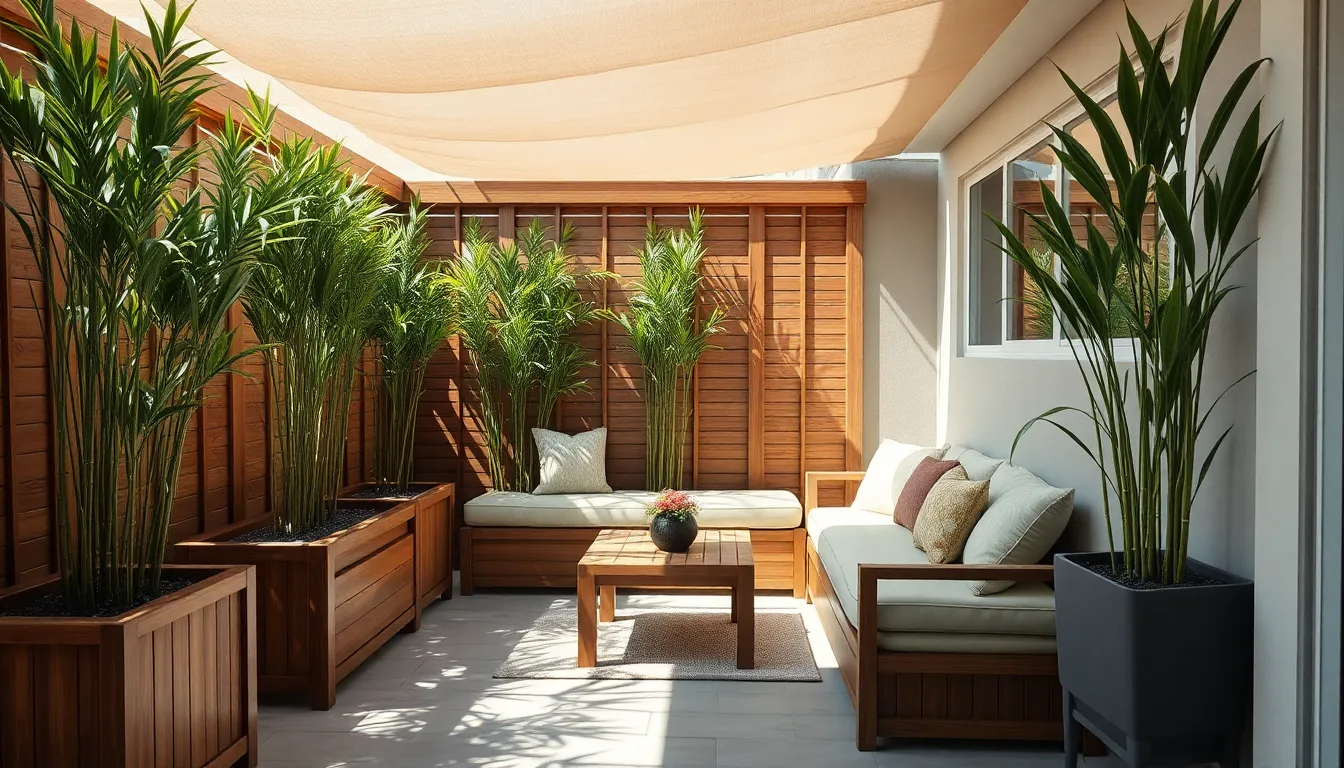
We’ll explore versatile patio enclosure designs that serve multiple functions while keeping costs manageable. These smart answers maximize your outdoor space’s potential without requiring extensive renovations.
Storage Integration Within Walls
Built-in storage transforms your enclosed patio walls into functional organizers that eliminate clutter while saving money on furniture. We recommend designing bench seating with hidden compartments underneath for storing cushions, garden tools, and outdoor equipment. Wall-mounted cabinets can be constructed using basic lumber and hinges, creating dedicated spaces for entertaining essentials like dishes, games, or seasonal decorations.
Corner storage units maximize unused wall space by incorporating triangular shelving or cabinet systems that fit snugly into tight areas. These installations keep your patio organized without requiring additional floor space or separate storage furniture purchases.
Planters as Natural Barriers
Large planters filled with tall plants create beautiful privacy screens that define your enclosed patio boundaries affordably. We suggest using bamboo, ornamental grasses, or evergreen shrubs in oversized containers to establish natural barriers between your patio and yard areas. These green dividers maintain airflow and natural light while providing the privacy you need.
Raised planter beds can double as seating ledges when built at the appropriate height, typically 18-20 inches from the ground. This dual-purpose approach combines landscaping with functional furniture, reducing overall project costs while adding visual appeal to your outdoor space.
Seating Built Into Enclosure Structures
Integrated seating eliminates the need to purchase expensive outdoor furniture by incorporating benches directly into your enclosure design. We recommend building wooden benches along walls or incorporating concrete seating into raised planter structures for durable, weather-resistant options. These permanent installations provide reliable seating that won’t need seasonal storage or replacement.
Cushioned bench tops using outdoor fabrics create comfortable relaxation spots without the expense of individual chairs or sofas. Built-in seating can follow the perimeter of your enclosed space, maximizing capacity while maintaining an open feel that makes smaller patios appear larger than their actual footprint.
Lighting Solutions for Enclosed Patios on a Budget
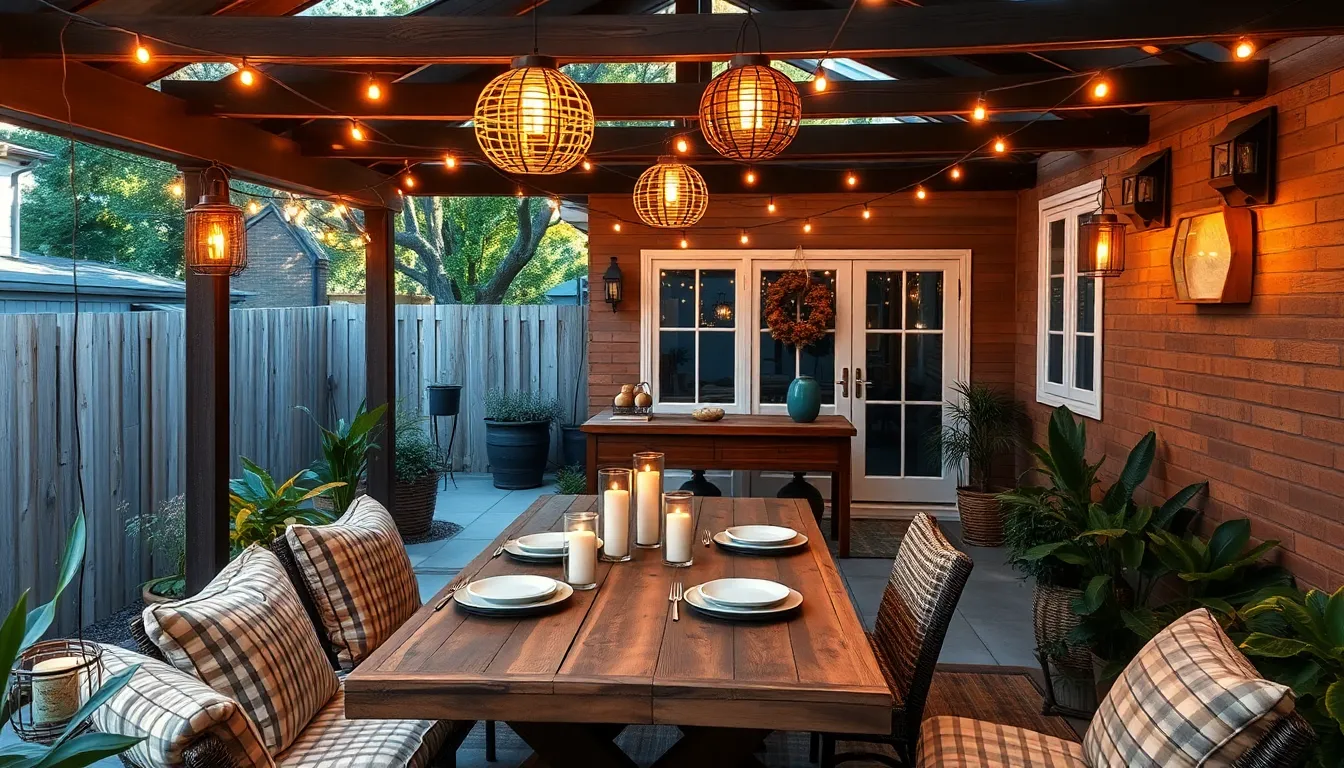
Creating the perfect ambiance for your enclosed patio doesn’t require expensive electrical work or professional installation. We’ve found three cost-effective lighting approaches that transform any enclosed space into a warm, inviting retreat.
String Light Installation Ideas
String lights rank among the most affordable and enchanting lighting answers for enclosed patios. Draping these versatile lights around beams, railings, or ceiling edges creates instant cozy warmth that welcomes guests and family alike. Globe string lights and Edison bulb styles add vintage charm and character to your space, while fairy lights deliver a magical glow that’s perfect for romantic evenings.
Measuring your patio area before purchasing ensures you’ll buy the right length to cover your space effectively. Wrapping lights around structural elements like posts or overhead beams maximizes coverage while creating visual interest. Installing permanent hooks or eye screws makes seasonal setup and removal much easier for long-term use.
Solar-Powered Lighting Options
Solar-powered lights offer a cost-effective and eco-friendly choice that eliminates wiring needs and reduces electricity bills. These innovative fixtures charge during daylight hours and automatically provide soft illumination throughout the evening. Solar string lights and lanterns can be strategically placed to highlight seating areas, dining spaces, or architectural features without any ongoing electrical costs.
Positioning solar panels in areas that receive direct sunlight ensures optimal charging and longer nighttime operation. Battery backup systems in quality solar lights maintain consistent performance even during cloudy periods. Weather-resistant designs protect your investment while delivering reliable illumination season after season.
DIY Lantern and Fixture Projects
Creating custom lanterns and light fixtures saves money while adding personal touches to your enclosed patio design. Mason jars, tin cans, and repurposed glass containers make excellent lantern bases when paired with candles or battery-operated LED lights. These handcrafted pieces can be hung from ceiling hooks or arranged on tables to create layered lighting throughout your space.
Crafting fixtures using affordable materials like reclaimed wood or salvaged metal complements your patio’s style without heavy expenses. Building simple pendant lights with basic electrical components costs significantly less than store-bought alternatives. Personalizing each fixture with paint, stains, or decorative elements ensures your lighting perfectly matches your enclosed patio’s unique aesthetic.
Flooring Updates That Won’t Break the Bank
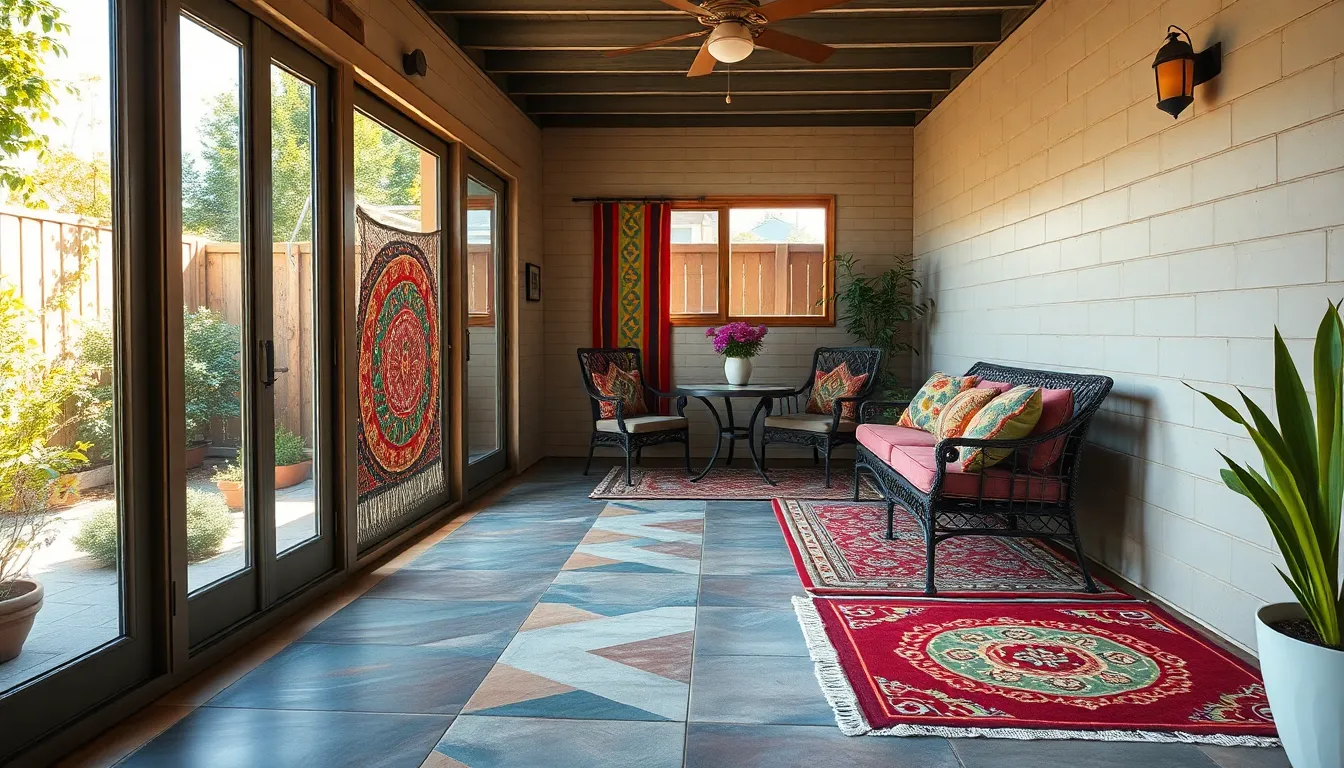
Now that we’ve covered enclosure options, let’s focus on transforming your patio floor without draining your savings account.
Outdoor Rug Layering Techniques
Outdoor rugs create instant warmth and style when layered over existing concrete or tile surfaces. We can add texture, color, and comfort to our enclosed patio spaces using weather-resistant rugs designed to withstand moisture and UV rays. Different sizes and patterns allow us to define separate areas within our patio while maintaining visual interest.
Layering different rugs helps us create ever-changing visual zones without expensive flooring installation. Weather-resistant materials ensure our investment lasts through seasons of use. Pattern mixing becomes effortless when we choose rugs with complementary colors but varying designs.
Strategic placement transforms awkward patio layouts into functional living spaces. Large rugs anchor seating areas while smaller accent pieces define walkways or dining zones. Outdoor rug materials resist fading and moisture damage better than indoor alternatives.
Painted Concrete Transformations
Painted concrete offers one of the most cost-effective ways to refresh our patio flooring completely. Outdoor paint or concrete stain transforms dull gray surfaces into colorful, patterned floors that rival expensive tile installations. DIY application requires minimal materials while creating durable surfaces that withstand weather and foot traffic.
Concrete stain penetrates the surface for longer-lasting color compared to surface paint alone. Sealants applied after painting provide additional protection against weather damage and wear patterns. Pattern creation using stencils or tape allows us to mimic expensive tile or stone looks.
Color selection dramatically impacts our patio’s overall atmosphere and style direction. Light colors reflect heat and create spacious feelings while darker tones add drama and hide stains better. Multiple color applications can create geometric patterns or artistic designs.
Interlocking Tile Answers
Interlocking patio tiles made from wood, composite, or plastic materials snap together easily over existing concrete floors. Professional installation becomes unnecessary when we choose these user-friendly flooring options that require no special tools or expertise. Flexibility remains high since we can rearrange or replace individual tiles as needed.
Wood composite tiles provide natural wood appearance without the maintenance requirements of solid lumber. Plastic options resist moisture and staining while offering various colors and textures. Installation time drops significantly compared to traditional tile or stone flooring projects.
Snap together systems allow us to cover large areas quickly without adhesives or grout lines. Damaged tiles can be replaced individually rather than requiring entire floor refinishing. Removal remains simple if we decide to change our flooring again later.
Heating and Cooling for Year-Round Comfort
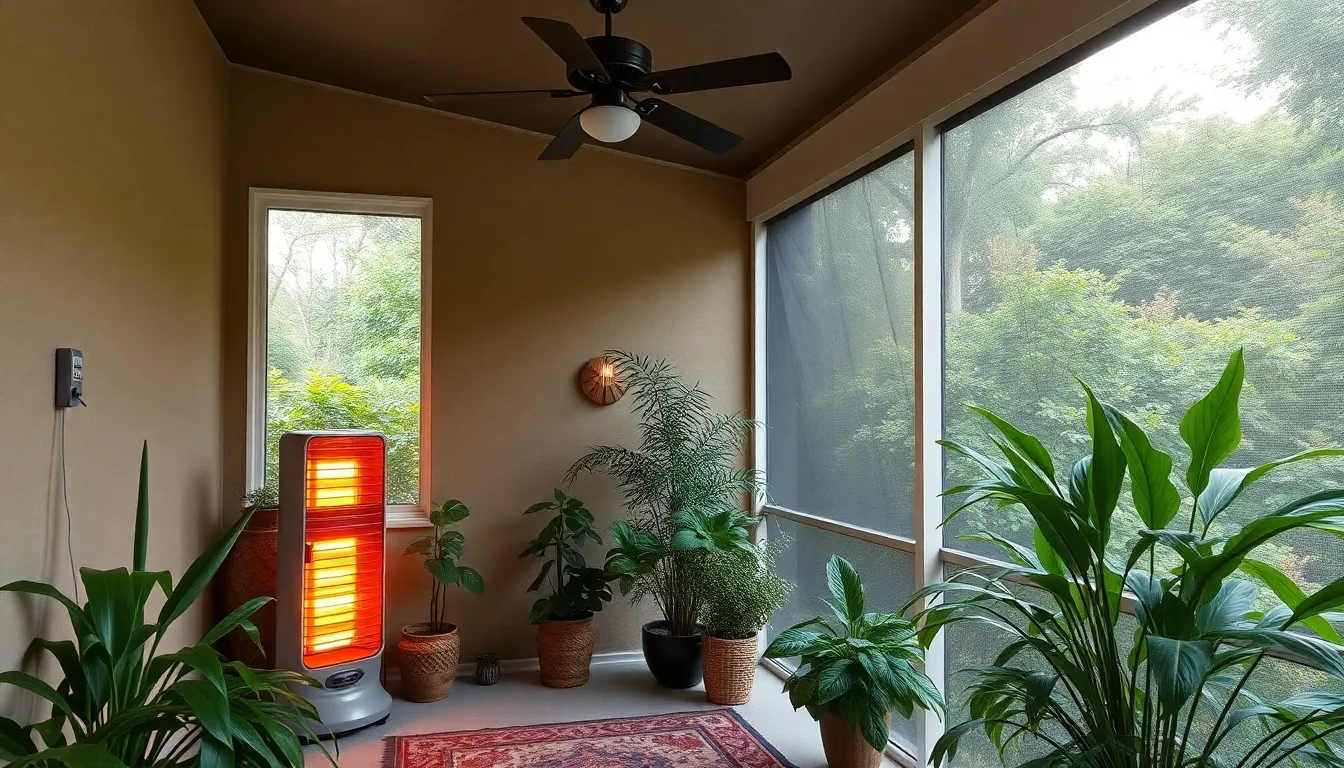
Creating a comfortable temperature in our enclosed patio ensures we can enjoy the space throughout all seasons. Smart heating and cooling answers keep costs manageable while maximizing our patio’s usability.
Space Heater Safety and Placement
Electric space heaters designed for outdoor or semi-enclosed spaces provide efficient warmth during cooler months. We should choose models with built-in safety features like tip-over shutoff and overheat protection to prevent accidents.
Positioning heaters on flat, stable surfaces away from flammable materials like curtains or furniture prevents fire hazards. Manufacturers typically recommend maintaining 3-foot clearances around the heater for safe operation. Direct electrical connections work best since extension cords can create safety risks with outdoor heating equipment.
Supervision remains essential whenever we operate space heaters in our enclosed patio. Never leaving heaters unattended while running eliminates potential fire dangers and ensures peace of mind during relaxation time.
Fan Installation for Air Circulation
Ceiling fans suited for outdoor use improve air circulation, reduce humidity, and enhance comfort during warm weather. We can install wall-mounted or standing fans in larger patios to target exact seating areas where we spend the most time.
Strategic fan placement that complements natural breeze directions maximizes airflow without creating uncomfortable drafts. Ceiling and wall-mounted fans help distribute heated air evenly during winter months while providing cooling relief in summer.
Proper fan installation ensures optimal air movement throughout our enclosed space. We should consider the patio’s layout and our preferred seating arrangements when determining the best fan locations for maximum comfort.
Natural Ventilation Design Tips
Large screened openings or sliding screen doors enable effective cross-ventilation throughout our enclosed patio. We can incorporate these features during the initial enclosure process to maintain airflow without expensive mechanical systems.
Lightweight curtains or shades allow air movement while blocking harsh sunlight and maintaining privacy. Positioning our enclosed patio to take advantage of prevailing winds provides natural cooling that reduces our reliance on electric fans.
Trellises or pergolas with climbing plants create shade while allowing beneficial airflow through the space. We can design these natural elements to work with our existing enclosure materials, creating an integrated system that promotes comfortable temperatures year-round.
Conclusion
Creating our dream enclosed patio doesn’t have to drain our savings account. We’ve explored many budget-friendly options that prove smart planning and creativity can transform any outdoor space into a year-round retreat.
From DIY screens and repurposed materials to multi-functional designs and seasonal answers we’ve discovered that working within budget constraints often leads to more innovative and personalized results. These cost-effective approaches allow us to enjoy the benefits of an enclosed patio while maintaining financial flexibility for other home improvements.
The key to success lies in choosing answers that match our exact needs climate and skill level. Whether we opt for removable panels fabric enclosures or repurposed materials the goal remains the same: creating a comfortable functional space that extends our living area without very costly.
Start with one project and build from there. Our perfect enclosed patio awaits and it’s more affordable than we might think.
Frequently Asked Questions
What is the most cost-effective way to enclose a patio?
DIY screen installations using pressure-treated lumber and standard fiberglass screening offer the most budget-friendly approach. You can also repurpose materials like old wooden pallets, salvaged windows, or doors to create unique enclosures. These methods typically cost a fraction of professional installations while providing excellent weather protection.
How much does it cost to build a DIY screen enclosure?
A basic DIY screen enclosure using pressure-treated lumber and fiberglass screening typically costs between $200-800, depending on the patio size. This includes materials for framing, screening, and basic hardware. Costs can be reduced further by using repurposed materials like pallets or salvaged windows.
What are good alternatives to expensive glass panels?
Acrylic sheeting (plexiglass) is an excellent alternative, offering impact resistance and clear visibility at 50-70% less cost than glass. Clear vinyl curtains provide temporary seasonal protection, while polycarbonate panels offer durability and UV protection. These options maintain functionality while significantly reducing expenses.
Can I create a seasonal enclosure that’s removable?
Yes, removable options include snap-on panel systems, heavy-duty clear vinyl curtains, and retractable mesh screens. These solutions allow you to adapt your patio for different seasons without permanent modifications, making them ideal for renters or those wanting flexibility throughout the year.
What repurposed materials work best for patio enclosures?
Vintage windows, wooden pallets, and salvaged doors are excellent repurposed materials. Windows provide natural light and weather protection, pallets create rustic wall sections, and old doors add character while serving as functional barriers. Proper weatherproofing and framing ensure these materials remain durable.
How can I add storage to my enclosed patio without buying furniture?
Build storage directly into your enclosure design with bench seating featuring hidden compartments, wall-mounted cabinets, or raised planter beds that double as seating. These integrated solutions eliminate the need for separate furniture purchases while maximizing your space’s functionality.
What are budget-friendly lighting options for enclosed patios?
String lights offer the most affordable ambiance, costing $20-50 for most spaces. Solar-powered lights provide eco-friendly illumination without electrical costs. DIY lanterns made from repurposed materials like mason jars or tin cans create custom lighting solutions for under $10 each.
How can I update my patio flooring on a budget?
Outdoor rugs provide instant style and warmth over existing surfaces for $30-150. Painted concrete offers a colorful refresh using specialty concrete paint for $50-100. Interlocking patio tiles (wood, composite, or plastic) create professional looks for $2-8 per square foot with easy DIY installation.
What heating and cooling options work best for enclosed patios?
Electric space heaters designed for outdoor use provide safe winter warmth for $50-200. Ceiling or wall-mounted fans improve summer comfort for $75-300. Natural ventilation through strategic screened openings and design elements like trellises offer cost-free temperature regulation year-round.
Are fabric enclosures durable enough for year-round use?
Quality outdoor fabrics like canvas tarps and marine-grade materials can withstand year-round weather when properly installed and maintained. Drop cloth curtains offer budget-friendly seasonal protection, while heavy-duty canvas provides robust weather resistance. Regular cleaning and proper tensioning extend their lifespan significantly.

